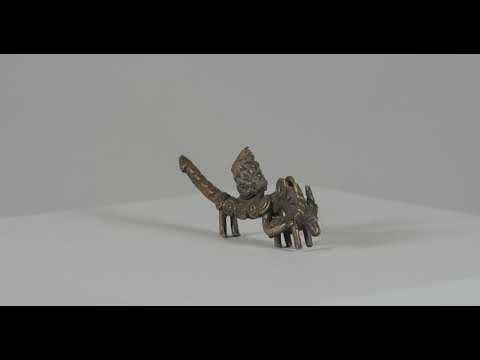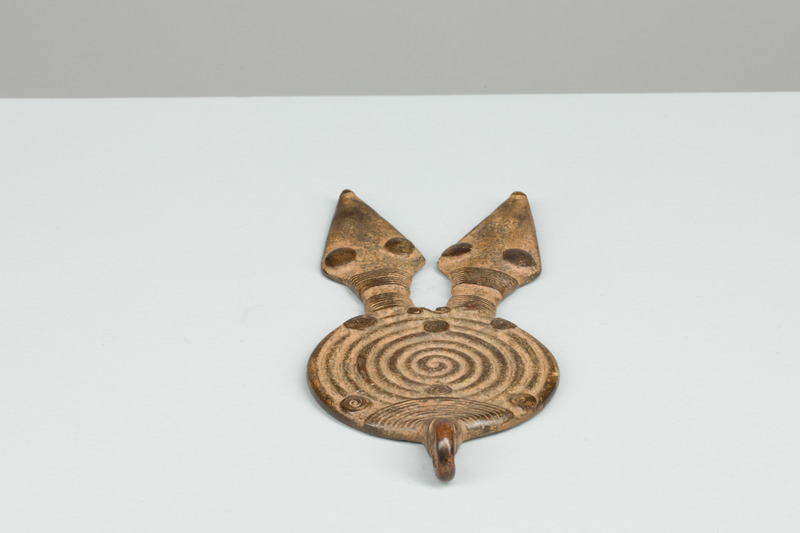Catalogue 23
Pendant Amulet
Gan people, Bukina Faso
20th century
Brass; 1 3/4 x 4 1/8 x 9/16 inches (4.5 x 10.5 x 1.5 cm)
Collection of Allen and Barbara Davis
Pendant Amulet
Tusian (Win) people, Bukina Faso
20th century
Brass with leather cord; 4 1/2 x 2 x 1/2 inches (11.4 x 5.1 x 0.3 cm)
Collection of Allen and Barbara Davis
Small cast-brass amulets used as protective devices are found among many groups living in the area where the countries of Burkina Faso, Côte d’Ivoire, and Mali meet. These two pendant amulets, one representing two coiled snakes and the other a leopard devouring his prey, are from the Gan people and the Tusian (Win) people, respectively.
The Gan, who live in the savannah region in southwest Burkina Faso, are the only group in this area that have a centralized kingdom. Their artworks are closely connected with the monarchy and its history, which continues into the present.
Gan metalwork combines imagery from the natural world with multilayered symbolism relating to the cults of historic individual women and men. Snake imagery is abundant in Gan art, and casters create a variety of serpent images, all of which are considered sacred and are related to kingship. Smaller pendants, like this small double-snake amulet, are part of this tradition and would be worn to protect an individual from the imminent dangers of everyday life.
Among the Tusian (Win) peoples living in the southwestern region of Burkina Faso, miniature brass sculptures are used in divination and for healing rites and as amulets for male initiates. The pendant of a leopard (gango) devouring a gazelle was probably created for a new initiate in the Tusian men’s association to honor the spirit Do.
A Tusian client may buy a brass sculpture in one of the regional markets where vendors specialize in medicines made from plants and animals and in metal amulets, including brass, iron, copper, and alloyed metals. These vendors’ wares are primarily from regional markets and include both new and antique amulets. A client could also choose to commission an amulet from a local brasscaster.
In southwestern Burkina Faso, brasscasters are exclusive, self-contained groups who self-identify as Dioula or Gouin and produce amulets and other objects for both diviners and their clients of many ethnic backgrounds. Casters use the lost-wax process, creating delicate models from beeswax that are encased in a mold made from a mixture of termite-mound clay and ash. Today they use scrap metal such as copper plumbing pipes and wire supplied by a local vendor. In the past, their preferred source of their brass was French bullet casings. The brass they produce is more accurately described as a copper alloy that may have varying proportions of copper, zinc, and small quantities of other metals.
MJA
References
Cooksey, Susan. 2004. “Iron Staffs at the Crossroads: Art and Divination in Toussiana, a Southwestern Burkina Faso Community.” PhD diss., University of Iowa.
———. Forthcoming. “Brass Amulets and Spiritual Mediation in Southwestern Burkina Faso.” In Peace, Power, and Prestige: Metal Arts in Africa, edited by Susan Cooksey. Gainesville: Samuel P. Harn Museum of Art / University Press of Florida.
Fenton, Rebecca. Forthcoming. “Sculptures That Act.” In Peace, Power, and Prestige: Metal Arts in Africa, edited by Susan Cooksey. Gainesville: Samuel P. Harn Museum of Art / University Press of Florida.





























